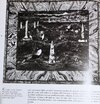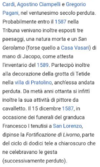LITTLE DOCTOR
Member
- Messages
- 281
In passato esistevano altre rappresentazioni artistiche raffiguranti il Cristo crocefisso al contrario. Al monastero della Sambuca era presente un affresco dal significato esplicito raffigurante il Cristo crocefisso al contrario che fu rimosso nel dopoguerra. Un formidabile mosaico era presente nella chiesa degli armeni danneggiata dal bombardamento di Livorno durante la seconda guerra mondiale. Il mosaico in questione rappresentava una crocefissione al contrario con alla base della croce una Magdalena nuda che porgeva tra le mani del carnefice romano alcune monete d’oro. Un mosaico in scala di quello presente nella chiesa degli armeni era riprodotto all’interno del castello ubicato nei pressi della stazione ferroviaria di Livorno, anch’esso colpito durante lo stesso bombardamento che danneggiò la chiesa degli armeni. Nonostante il castello fosse stato danneggiato solo in parte, fu deciso di raderlo al suolo.
Nella Bibbia catara viene riportato anche il motivo per cui il “Cristo” venne crocefisso al contrario e sarà mia premura svelarlo al momento opportuno. Inoltre, sempre secondo la Bibbia catara, la corona di spine che cingeva il capo del Cristo venne conficcata ancor più profondamente, proprio nel momento stesso che “Egli” usciva dalla prigione per essere giustiziato.
Questo fu fatto affinché le spine, entrando nella carne viva del condannato, facessero sgorgare sangue da tutti i lati, rendendo il volto una maschera di sangue non più riconoscibile… ma questa è un’altra storia…
Chiudo questa lunga, ma dovuta parentesi riguardante la crocefissione, dal momento che i tempi non sono ancora maturi per svelare il mistero, che sarà affrontato al momento opportuno.
Adesso tornerò a narrare le vicende del monastero del Conventaccio.
Come promesso Roberto da Volterra mostrò le preziose reliquie. Lo stupore e la meraviglia fu tale che il rettore della chiesa di san Jacopo, tale Galgano, ebbe l’ispirazione di chiedere a Roberto di poter diventare anch’esso cavaliere templare, in modo da poter custodire le reliquie. Infatti Galgano non tornò mai più a san Jacopo e al suo posto dovettero nominare un nuovo priore, certo “fratello Luca”. Roberto mostrò pure il trono dei giudei che gli eremiti neri avevano denominato già da tempo lo “specchio del Romitone”, macchinario che il “Predicatore” volle sottrarre dal controllo delle monache sepolcrine, fatto che determinò il drammatico epilogo e la fine degli eremiti neri e del loro conventaccio…
(English)
In the past there were other artistic representations depicting the crucified Christ upside down. At the Sambuca monastery there was a fresco with an explicit meaning depicting the crucified Christ upside down which was removed after the war. A formidable mosaic was present in the church of the Armenians damaged by the bombing of Livorno during the Second World War. The mosaic in question represented a reverse crucifixion with a naked Magdalena at the base of the cross holding out some gold coins in the hands of the Roman executioner. A scale mosaic of the one present in the Armenian church was reproduced inside the castle located near the Livorno railway station, which was also hit during the same bombing that damaged the Armenian church. Although the castle was only partially damaged, it was decided to raze it to the ground.
The reason why the "Christ" was crucified upside down is also reported in the Cathar Bible and I will be careful to reveal it at the right time. Furthermore, always according to the Cathar Bible, the crown of thorns that encircled the head of Christ was driven even more deeply, at the very moment that "He" came out of prison to be executed.
This was done so that the thorns, entering the living flesh of the condemned, caused blood to flow from all sides, making the face a mask of blood that was no longer recognizable... but that's another story...
I close this long but due parenthesis regarding the crucifixion, since the time is not yet ripe to reveal the mystery, which will be dealt with at the right time.
Now I will go back to narrating the events of the Conventaccio monastery.
As promised Roberto da Volterra showed the precious relics. The amazement and wonder was such that the rector of the church of San Jacopo, a certain Galgano, was inspired to ask Roberto to be able to become a Templar knight too, in order to be able to keep the relics. In fact Galgano never returned to San Jacopo and in his place they had to appoint a new prior, a certain "brother Luca". Roberto also showed the throne of the Jews that the black hermits had long since called the "mirror of Romitone", a machine that the "Preacher" wanted to remove from the control of the sepulchre nuns, a fact which determined the dramatic epilogue and the end of the black hermits and of their convent…
Nella Bibbia catara viene riportato anche il motivo per cui il “Cristo” venne crocefisso al contrario e sarà mia premura svelarlo al momento opportuno. Inoltre, sempre secondo la Bibbia catara, la corona di spine che cingeva il capo del Cristo venne conficcata ancor più profondamente, proprio nel momento stesso che “Egli” usciva dalla prigione per essere giustiziato.
Questo fu fatto affinché le spine, entrando nella carne viva del condannato, facessero sgorgare sangue da tutti i lati, rendendo il volto una maschera di sangue non più riconoscibile… ma questa è un’altra storia…
Chiudo questa lunga, ma dovuta parentesi riguardante la crocefissione, dal momento che i tempi non sono ancora maturi per svelare il mistero, che sarà affrontato al momento opportuno.
Adesso tornerò a narrare le vicende del monastero del Conventaccio.
Come promesso Roberto da Volterra mostrò le preziose reliquie. Lo stupore e la meraviglia fu tale che il rettore della chiesa di san Jacopo, tale Galgano, ebbe l’ispirazione di chiedere a Roberto di poter diventare anch’esso cavaliere templare, in modo da poter custodire le reliquie. Infatti Galgano non tornò mai più a san Jacopo e al suo posto dovettero nominare un nuovo priore, certo “fratello Luca”. Roberto mostrò pure il trono dei giudei che gli eremiti neri avevano denominato già da tempo lo “specchio del Romitone”, macchinario che il “Predicatore” volle sottrarre dal controllo delle monache sepolcrine, fatto che determinò il drammatico epilogo e la fine degli eremiti neri e del loro conventaccio…
(English)
In the past there were other artistic representations depicting the crucified Christ upside down. At the Sambuca monastery there was a fresco with an explicit meaning depicting the crucified Christ upside down which was removed after the war. A formidable mosaic was present in the church of the Armenians damaged by the bombing of Livorno during the Second World War. The mosaic in question represented a reverse crucifixion with a naked Magdalena at the base of the cross holding out some gold coins in the hands of the Roman executioner. A scale mosaic of the one present in the Armenian church was reproduced inside the castle located near the Livorno railway station, which was also hit during the same bombing that damaged the Armenian church. Although the castle was only partially damaged, it was decided to raze it to the ground.
The reason why the "Christ" was crucified upside down is also reported in the Cathar Bible and I will be careful to reveal it at the right time. Furthermore, always according to the Cathar Bible, the crown of thorns that encircled the head of Christ was driven even more deeply, at the very moment that "He" came out of prison to be executed.
This was done so that the thorns, entering the living flesh of the condemned, caused blood to flow from all sides, making the face a mask of blood that was no longer recognizable... but that's another story...
I close this long but due parenthesis regarding the crucifixion, since the time is not yet ripe to reveal the mystery, which will be dealt with at the right time.
Now I will go back to narrating the events of the Conventaccio monastery.
As promised Roberto da Volterra showed the precious relics. The amazement and wonder was such that the rector of the church of San Jacopo, a certain Galgano, was inspired to ask Roberto to be able to become a Templar knight too, in order to be able to keep the relics. In fact Galgano never returned to San Jacopo and in his place they had to appoint a new prior, a certain "brother Luca". Roberto also showed the throne of the Jews that the black hermits had long since called the "mirror of Romitone", a machine that the "Preacher" wanted to remove from the control of the sepulchre nuns, a fact which determined the dramatic epilogue and the end of the black hermits and of their convent…
Last edited by a moderator:



